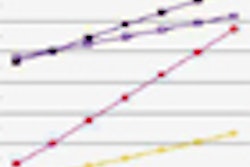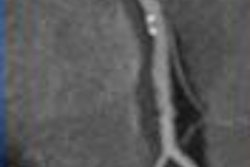Coronary CT angiography (CTA) can reduce the number of hospital admissions in patients with acute chest pain, saving money without putting patients at risk, according to a study presented this week at the American College of Cardiology (ACC) meeting in New Orleans.
"Our clinical study results showed that we could safely discharge low- to intermediate-risk patients with acute chest pain from the [emergency department (ED)] following a negative coronary CTA without any adverse outcome for six months following the ED visit," said lead author Dr. Michael Poon, professor of radiology and medicine at Stony Brook University School of Medicine, in a statement accompanying the study presentation.
"Additionally, we are able to identify those patients with early coronary artery disease and recommend early medical intervention with the assistance of their primary care physicians," he said.
Coronary CTA has been shown to be safe and cost-effective in the evaluation of acute chest pain patients. However, few studies have evaluated the technology's cost-savings potential in detail, wrote the authors in an abstract. The study aimed to evaluate the potential reduction in admissions among patients without obstructive coronary artery disease in a busy emergency department with 90,000 visits per year.
Among 1,089 patients presenting to the center, the study team focused on those with negative initial electrocardiogram and troponin levels, whom the emergency department staff considered to be at low risk of coronary artery disease. An additional 4,556 patients who did not undergo coronary CTA served as a control group.
Obstructive coronary artery disease was defined as a 50% or greater luminal diameter stenosis in any major vessel on coronary CTA. Patients with known coronary artery disease were excluded.
Among the acute chest pain patients with coronary CTA showing obstructive coronary artery disease or nondiagnostic CTA, 72 (67%) were admitted, compared with only 89 (9%) of the normal or nonobstructive patients, the study authors wrote.
In the control group of 4,556 acute chest pain patients who did not undergo an initial CTA test, 2,283 (50%) were admitted and 792 (35%) were later discharged without a specific cardiac diagnosis.
In contrast, only 43 (27%) of patients who underwent initial coronary CTA were discharged without a specific cardiac diagnosis.
Coronary CTA is a cost-saving, resource-efficient imaging modality for evaluating acute chest pain "and might generate potential savings by admission avoidance and by reducing the need for subsequent noninvasive and invasive testing," the authors wrote.
"Our data showed that coronary CTA saved more than 30% of unnecessary admissions each year compared to stress testing," Poon said in his statement. Without the benefit of coronary CTA, about 50% of acute chest pain patients were admitted, while the level dropped to 15% for patients who were scanned.
"Each unnecessary admission costs the hospital approximately $5,000. Thus for every 250 patients, the hospital saved approximately $1.3 million," Poon said.
"We strongly believe that we have developed a robust, revolutionary, and state-of-the-art methodology for the evaluation of acute chest pain in the ED, and this can be done seven days a week with excellent clinical outcome and is cost-effective," Poon said.
In an age of crimped healthcare budgets, the study's use of coronary CTA "reduces costs without compromising quality of care," commented Dr. Steven Strongwater, Stony Brook University Hospital's CEO.
In addition, treadmill tests are inadequate because they often fail to diagnose obstructive coronary artery disease until it's too late to treat medically or through lifestyle modification, Poon said. "Conventional diagnostic tests often give false-positive test results, leading to unnecessary invasive procedures and interventions, including coronary stenting and surgery," he said.
In contrast, with coronary CTA, patients with early coronary artery disease can be referred to their primary care physicians for early medical intervention and lifestyle recommendations, Poon said.




















